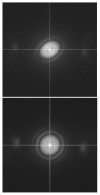Murphy's law-if anything can go wrong, it will: Problems in phage electron microscopy
- PMID: 23050222
- PMCID: PMC3442825
- DOI: 10.4161/bact.20693
Murphy's law-if anything can go wrong, it will: Problems in phage electron microscopy
Abstract
The quality of bacteriophage electron microscopy appears to be on a downward course since the 1980s. This coincides with the introduction of digital electron microscopes and a general lowering of standards, possibly due to the disappearance of several world-class electron microscopists The most important problem seems to be poor contrast. Positive staining is frequently not recognized as an undesirable artifact. Phage parts, bacterial debris, and aberrant or damaged phage particles may be misdiagnosed as bacterial viruses. Digital electron microscopes often seem to be operated without magnification control because this is difficult and inconvenient. In summary, most phage electron microscopy problems may be attributed to human failure. Journals are a last-ditch defense and have a heavy responsibility in selecting competent reviewers and rejecting, or not, unsatisfactory articles.
Figures



References
-
- Ackermann H-W. Declining electron microscopy. BEG News 21:2-3, http://www.phage.org/—Reprinted in Lab News 2004 (12):25.
-
- Ackermann H-W, DuBow MS. Viruses of Prokaryotes. Vol I. General Properties of Bacteriophages. CRC Press, Boca Raton, FL, 1987; 70-74; ISBN 0-8493-6056-0.
-
- Ackermann H-W, Heldal M. Basic electron microscopy of aquatic viruses. In: Wilhelm S, Weinbauer SM, Suttle CA, eds. Manual of Aquatic Virus Ecology, American Society for Limnology and Oceanography (ASLO), Waco, TX, 2009; 182-192; doi:10.4319/mave.2010.978-0-9845591-0-7-182
LinkOut - more resources
Full Text Sources
Molecular Biology Databases
